Heatwaves Significantly Slow the Vegetation Growth Rate on the Tibetan Plateau
Abstract
:1. Introduction
2. Materials and Methods
2.1. Study Area
2.2. Datasets
2.3. Methods
3. Results
3.1. Trends of Heatwaves Frequency
3.2. Effects of Heatwaves on Vegetation
4. Discussion
5. Conclusions
Author Contributions
Funding
Data Availability Statement
Acknowledgments
Conflicts of Interest
Appendix A
| WMO Code | Station Name | Latitude | Longitude | Elevation (m) |
|---|---|---|---|---|
| 52602 | Lenghu | 38.75 | 93.33 | 2770 |
| 52707 | Xiaozaohuo | 36.80 | 93.68 | 2767 |
| 52787 | Wushaoling | 37.20 | 102.87 | 3045.1 |
| 52818 | Golmud | 36.42 | 94.90 | 2807.6 |
| 52825 | Nuomuhong | 36.43 | 96.42 | 2790.4 |
| 52836 | Doulan | 36.30 | 98.10 | 3191.1 |
| 52856 | Gonghe | 36.27 | 100.62 | 2835 |
| 52866 | Xining | 36.72 | 101.75 | 2295.2 |
| 52868 | Guide | 36.03 | 101.43 | 2237.1 |
| 52908 | Wudaoliang | 35.22 | 93.08 | 4612.2 |
| 52943 | Xinghai | 35.58 | 99.98 | 3323.2 |
| 52955 | Guihan | 35.58 | 100.75 | 3202.9 |
| 52974 | Tongren | 35.52 | 102.02 | 2491.4 |
| 55228 | Shiquanhe | 32.50 | 80.08 | 4278 |
| 55248 | Gaize | 32.15 | 84.42 | 4414.9 |
| 55299 | Naqu | 31.48 | 92.07 | 4507 |
| 55437 | Pulan | 30.28 | 81.25 | 3900 |
| 55493 | Dangxiong | 30.48 | 91.10 | 4200 |
| 55569 | Lazi | 29.08 | 87.60 | 4000 |
| 55598 | Shannan | 29.25 | 91.77 | 3551.7 |
| 55655 | Nielaer | 28.18 | 85.97 | 3810 |
| 55664 | Dingri | 28.63 | 87.08 | 4300 |
| 55680 | Jiangzi | 28.92 | 89.60 | 4040 |
| 56004 | Tuotuohe | 34.22 | 92.43 | 4533.1 |
| 56018 | Zaduo | 32.90 | 95.30 | 4066.4 |
| 56021 | Qumalai | 34.13 | 95.78 | 4175 |
| 56029 | Yushu | 33.02 | 97.02 | 3681.2 |
| 56033 | Maduo | 34.92 | 98.22 | 4272.3 |
| 56034 | Qingshuihe | 33.80 | 97.13 | 4415.4 |
| 56038 | Shiqu | 32.98 | 98.10 | 4200 |
| 56043 | Guoluo | 34.47 | 100.25 | 3719 |
| 56046 | Dari | 33.75 | 99.65 | 3967.5 |
| 56065 | Henan | 34.73 | 101.60 | 3500 |
| 56067 | Jiuzhi | 33.43 | 101.48 | 3628.5 |
| 56074 | Maqu | 34.00 | 102.08 | 3471.4 |
| 56079 | Ruoergai | 33.58 | 102.97 | 3439.6 |
| 56080 | Hezuo | 35.00 | 102.90 | 2910 |
| 56116 | Qingqing | 31.42 | 95.60 | 3873.1 |
| 56125 | Nangqian | 32.20 | 96.48 | 3643.7 |
| 56137 | Changdu | 31.15 | 97.17 | 3306 |
| 56144 | Dege | 31.80 | 98.58 | 3184 |
| 56146 | Ganzi | 31.62 | 100.00 | 3393.5 |
| 56151 | Banma | 32.93 | 100.75 | 3530 |
| 56152 | Seda | 32.28 | 100.33 | 3893.9 |
| 56167 | Daodu | 30.98 | 101.12 | 2957.2 |
| 56172 | Maerkang | 31.90 | 102.23 | 2664.4 |
| 56173 | Hongyuan | 32.80 | 102.55 | 3491.6 |
| 56178 | Xiaojing | 31.00 | 102.35 | 2369.2 |
| 56182 | Songpan | 32.65 | 103.57 | 2850.7 |
| 56223 | Luolong | 30.75 | 95.83 | 3640 |
| 56227 | Bomi | 29.87 | 95.77 | 2736 |
| 56247 | Batang | 30.00 | 99.10 | 2589.2 |
| 56251 | Xinlong | 30.93 | 100.32 | 3000 |
| 56257 | Litang | 30.00 | 100.27 | 3948.9 |
| 56312 | Linzhi | 29.67 | 94.33 | 2991.8 |
| 56331 | Zuogong | 29.67 | 97.83 | 3780 |
| 56357 | Daocheng | 29.05 | 100.30 | 3727.7 |
| 56374 | Kangding | 30.05 | 101.97 | 2615.7 |
| 56434 | Chayu | 28.65 | 97.47 | 2327.6 |
| 56444 | Deqin | 28.48 | 98.92 | 3319 |
| 56459 | Muli | 27.93 | 101.27 | 2426.5 |
| 56462 | Jiulong | 29.00 | 101.50 | 2987.3 |
| 56533 | Gongshan | 27.75 | 98.67 | 1583.3 |
| 56543 | Zhongdian | 27.83 | 99.70 | 3276.1 |
References
- Lavaysse, C.; Cammalleri, C.; Dosio, A.; van der Schrier, G.; Toreti, A.; Vogt, J. Towards a monitoring system of temperature extremes in Europe. Nat. Hazards Earth Syst. Sci. 2018, 18, 91–104. [Google Scholar] [CrossRef] [Green Version]
- Perkins-Kirkpatrick, S.E.; Lewis, S.C. Increasing trends in regional heatwaves. Nat. Commun. 2020, 11, 3357. [Google Scholar] [CrossRef]
- Reichstein, M.; Bahn, M.; Ciais, P.; Frank, D.; Mahecha, M.D.; Seneviratne, S.I.; Zscheischler, J.; Beer, C.; Buchmann, N.; Frank, D.C.; et al. Climate extremes and the carbon cycle. Nature 2013, 500, 287–295. [Google Scholar] [CrossRef]
- Wang, R.; He, M.; Niu, Z. Responses of Alpine Wetlands to Climate Changes on the Qinghai-Tibetan Plateau Based on Remote Sensing. Chin. Geogr. Sci. 2020, 30, 189–201. [Google Scholar] [CrossRef]
- Piao, S.; Zhang, X.; Chen, A.; Liu, Q.; Lian, X.; Wang, X.; Peng, S.; Wu, X. The impacts of climate extremes on the terrestrial carbon cycle: A review. Sci. China Earth Sci. 2019, 62, 1551–1563. [Google Scholar] [CrossRef]
- Yan, Y.; Jeong, S.; Park, C.-E.; Mueller, N.D.; Piao, S.; Park, H.; Joo, J.; Chen, X.; Wang, X.; Liu, J.; et al. Effects of extreme temperature on China’s tea production. Environ. Res. Lett. 2021, 16, 044040. [Google Scholar] [CrossRef]
- Lobell, D.B.; Bänziger, M.; Magorokosho, C.; Vivek, B. Nonlinear heat effects on African maize as evidenced by historical yield trials. Nat. Clim. Chang. 2011, 1, 42–45. [Google Scholar] [CrossRef]
- Klesse, S.; Babst, F.; Lienert, S.; Spahni, R.; Joos, F.; Bouriaud, O.; Carrer, M.; Di Filippo, A.; Poulter, B.; Trotsiuk, V.; et al. A Combined Tree Ring and Vegetation Model Assessment of European Forest Growth Sensitivity to Interannual Climate Variability. Glob. Biogeochem. Cycles 2018, 32, 1226–1240. [Google Scholar] [CrossRef]
- Bastos, A.; Gouveia, C.M.; Trigo, R.M.; Running, S.W. Analysing the spatio-temporal impacts of the 2003 and 2010 extreme heatwaves on plant productivity in Europe. Biogeosciences 2014, 11, 3421–3435. [Google Scholar] [CrossRef] [Green Version]
- Mou, C.; Sun, G.; Luo, P.; Wang, Z.; Luo, G. Flowering Responses of Alpine Meadow Plant in the Qinghai-Tibetan Plateau to Extreme Drought Imposed in Different Periods. Chin. J. Appl. Environ. Biol. 2013, 19, 272–279. [Google Scholar] [CrossRef]
- Qin, C.; Yang, B.; Bräuning, A.; Sonechkin, D.M.; Huang, K. Regional extreme climate events on the northeastern Tibetan Plateau since AD 1450 inferred from tree rings. Glob. Planet Chang. 2011, 75, 143–154. [Google Scholar] [CrossRef]
- Zhou, Y.; Pei, F.; Xia, Y.; Wu, C.; Zhong, R.; Wang, K.; Wang, H.; Cao, Y. Assessing the Impacts of Extreme Climate Events on Vegetation Activity in the North South Transect of Eastern China (NSTEC). Water 2019, 11, 2291. [Google Scholar] [CrossRef] [Green Version]
- Zaitchik, B.F.; Macalady, A.K.; Bonneau, L.R.; Smith, R.B. Europe’s 2003 heat wave: A satellite view of impacts and land–atmosphere feedbacks. Int. J. Climatol. 2006, 26, 743–769. [Google Scholar] [CrossRef]
- Baldwin, J.W.; Dessy, J.B.; Vecchi, G.A.; Oppenheimer, M. Temporally Compound Heat Wave Events and Global Warming: An Emerging Hazard. Earth’s Future 2019, 7, 411–427. [Google Scholar] [CrossRef] [Green Version]
- You, Q.; Kang, S.; Aguilar, E.; Yan, Y. Changes in daily climate extremes in the eastern and central Tibetan Plateau during 1961–2005. J. Geophys. Res. 2008, 113, D07101. [Google Scholar] [CrossRef] [Green Version]
- Li, Z.; Guo, X.; Yang, Y.; Hong, Y.; Wang, Z.; You, L. Heatwave Trends and the Population Exposure Over China in the 21st Century as Well as Under 1.5 °C and 2.0 °C Global Warmer Future Scenarios. Sustainability 2019, 11, 3318. [Google Scholar] [CrossRef] [Green Version]
- You, Q.; Kang, S.; Pepin, N.; Flügel, W.-A.; Sanchez-Lorenzo, A.; Yan, Y.; Zhang, Y. Climate warming and associated changes in atmospheric circulation in the eastern and central Tibetan Plateau from a homogenized dataset. Glob. Planet Chang. 2010, 72, 11–24. [Google Scholar] [CrossRef]
- Zhang, L.; Guo, H.; Ji, L.; Lei, L.; Wang, C.; Yan, D.; Li, B.; Li, J. Vegetation greenness trend (2000 to 2009) and the climate controls in the Qinghai-Tibetan Plateau. J. Appl. Remote Sens. 2013, 7, 073572. [Google Scholar] [CrossRef]
- Hua, T.; Wang, X. Temporal and Spatial Variations in the Climate Controls of Vegetation Dynamics on the Tibetan Plateau during 1982–2011. Adv. Atmos. Sci. 2018, 35, 1337–1346. [Google Scholar] [CrossRef]
- Zhang, F.; Cao, G. Resilience of Energy and CO2 Exchange to a Summer Heatwave in an Alpine Humid Grassland on the Qinghai-Tibetan Plateau. Pol. J. Environ. Stud. 2017, 26, 385–394. [Google Scholar] [CrossRef]
- He, S.; Richards, K.; Zhao, Z. Climate extremes in the Kobresia meadow area of the Qinghai-Tibetan Plateau, 1961–2008. Environ. Earth Sci. 2015, 75, 60. [Google Scholar] [CrossRef]
- Yang, L.; Wang, H.; Lu, T.; Liu, L.; Fu, W.; Wei, D. Characteristics of Air Temperature Variation in Lhasa City over the Past 49 Years. Earth Environ. 2021, 49, 492–503. [Google Scholar] [CrossRef]
- Li, C.; Wulf, H.; Schmid, B.; He, J.; Schaepman, M.E. Estimating Plant Traits of Alpine Grasslands on the Qinghai-Tibetan Plateau Using Remote Sensing. IEEE J. Sel. Top. Appl. Earth Obs. Remote Sens. 2018, 11, 2263–2275. [Google Scholar] [CrossRef]
- Yao, T.; Xue, Y.; Chen, D.; Chen, F.; Thompson, L.; Cui, P.; Koike, T.; Lau, W.K.M.; Lettenmaier, D.; Mosbrugger, V.; et al. Recent Third Pole’s Rapid Warming Accompanies Cryospheric Melt and Water Cycle Intensification and Interactions between Monsoon and Environment: Multidisciplinary Approach with Observations, Modeling, and Analysis. Bull. Am. Meteorol. Soc. 2019, 100, 423–444. [Google Scholar] [CrossRef]
- Chen, F.; Zhang, J.; Liu, J.; Cao, X.; Hou, J.; Zhu, L.; Xu, X.; Liu, X.; Wang, M.; Wu, D.; et al. Climate change, vegetation history, and landscape responses on the Tibetan Plateau during the Holocene: A comprehensive review. Quat. Sci. Rev. 2020, 243, 106444. [Google Scholar] [CrossRef]
- Bhattarai, P.; Zheng, Z.; Bhatta, K.P.; Adhikari, Y.P.; Zhang, Y. Climate-Driven Plant Response and Resilience on the Tibetan Plateau in Space and Time: A Review. Plants 2021, 10, 480. [Google Scholar] [CrossRef]
- Lucht, W.; Lewis, P. Theoretical noise sensitivity of BRDF and albedo retrieval from the EOS-MODIS and MISR sensors with respect to angular sampling. Int. J. Remote Sens. 2010, 21, 81–98. [Google Scholar] [CrossRef]
- Gao, X.; Huete, A.R.; Ni, W.; Miura, T. Optical–Biophysical Relationships of Vegetation Spectra without Background Contamination. Remote Sens. Environ. 2000, 74, 609–620. [Google Scholar] [CrossRef]
- Tucker, C.J. Red and Photographic Infrared Linear Combinations for Monitoring Vegetation. Remote Sens. Environ. 1979, 8, 127–150. [Google Scholar] [CrossRef] [Green Version]
- Huete, A.; Didan, K.; Miura, T.; Rodriguez, E.P.; Gao, X.; Ferreira, L.G. Overview of the radiometric and biophysical performance of the MODIS vegetation indices. Remote Sens. Environ. 2002, 83, 195–213. [Google Scholar] [CrossRef]
- Chai, L.; Zhu, Z.; Liu, S. Land Surface Soil Moisture Dataset of SMAP Time-Expanded Daily 0.25° × 0.25° over Qinghai-Tibet Plateau Area (SMsmapTE, V1). Natl. Tibet. Plateau Data Cent. 2020. [Google Scholar] [CrossRef]
- Qu, Y.; Zhu, Z.; Chai, L.; Liu, S.; Montzka, C.; Liu, J.; Yang, X.; Lu, Z.; Jin, R.; Li, X.; et al. Rebuilding a Microwave Soil Moisture Product Using Random Forest Adopting AMSR-E/AMSR2 Brightness Temperature and SMAP over the Qinghai–Tibet Plateau, China. Remote Sens. 2019, 11, 683. [Google Scholar] [CrossRef] [Green Version]
- You, Q.; Jiang, Z.; Kong, L.; Wu, Z.; Bao, Y.; Kang, S.; Pepin, N. A comparison of heat wave climatologies and trends in China based on multiple definitions. Clim. Dyn. 2016, 48, 3975–3989. [Google Scholar] [CrossRef] [Green Version]
- Li, X.; Ren, G.; Wang, S.; You, Q.; Sun, Y.; Ma, Y.; Wang, D.; Zhang, W. Change in the heatwave statistical characteristics over China during the climate warming slowdown. Atmos. Res. 2021, 247, 105152. [Google Scholar] [CrossRef]
- Ma, M.; Veroustraete, F. Reconstructing pathfinder AVHRR land NDVI time-series data for the Northwest of China. Adv. Space Res. 2006, 37, 835–840. [Google Scholar] [CrossRef]
- Zhang, H.; Ren, Z. Comparison and Application Analysis of Several NDVI Time-Series Reconstruction Methods. Sci. Agric. Sin. 2014, 47, 2998–3008. [Google Scholar] [CrossRef]
- Yan, B.; Lu, Z.; Li, J.; Huo, J. Analysis of Runoff Characteristics in Dry Season at Datong Station on the Mainstream of the Yangtze River. Environ. Earth Sci. 2021, 768, 012066. [Google Scholar] [CrossRef]
- Wang, X.; Xiao, J.; Li, X.; Cheng, G.; Ma, M.; Zhu, G.; Altaf Arain, M.; Andrew Black, T.; Jassal, R.S. No trends in spring and autumn phenology during the global warming hiatus. Nat. Commun. 2019, 10, 2389. [Google Scholar] [CrossRef]
- Sen, P.K. Estimates of the Regression Coefficient Based on Kendall’s Tau. J. Am. Stat. Assoc. 1968, 63, 1379–1389. [Google Scholar] [CrossRef]
- Liu, D.; Wang, T.; Yang, T.; Yan, Z.; Liu, Y.; Zhao, Y.; Piao, S. Deciphering impacts of climate extremes on Tibetan grasslands in the last fifteen years. Sci. Bull. 2019, 64, 446–454. [Google Scholar] [CrossRef] [Green Version]
- You, Q.; Fraedrich, K.; Ren, G.; Pepin, N.; Kang, S. Variability of temperature in the Tibetan Plateau based on homogenized surface stations and reanalysis data. Int. J. Climatol. 2013, 33, 1337–1347. [Google Scholar] [CrossRef] [Green Version]
- Hozain, M.I.; Salvucci, M.E.; Fokar, M.; Holaday, A.S. The differential response of photosynthesis to high temperature for a boreal and temperate Populus species relates to differences in Rubisco activation and Rubisco activase properties. Tree Physiol. 2010, 30, 32–44. [Google Scholar] [CrossRef] [Green Version]
- Chen, A.; Huang, L.; Liu, Q.; Piao, S. Optimal temperature of vegetation productivity and its linkage with climate and elevation on the Tibetan Plateau. Glob. Chang. Biol. 2021, 27, 1942–1951. [Google Scholar] [CrossRef]
- Fu, Z.; Ciais, P.; Bastos, A.; Stoy, P.C.; Yang, H.; Green, J.K.; Wang, B.; Yu, K.; Huang, Y.; Knohl, A.; et al. Sensitivity of gross primary productivity to climatic drivers during the summer drought of 2018 in Europe. Philos. Trans. R. Soc. Lond. B Biol. Sci. 2020, 375, 20190747. [Google Scholar] [CrossRef]
- Hatfield, J.L.; Prueger, J.H. Temperature extremes: Effect on plant growth and development. Weather Clim. Extrem. 2015, 10, 4–10. [Google Scholar] [CrossRef] [Green Version]
- Yu, H.; Xu, J.; Okuto, E.; Luedeling, E. Seasonal response of grasslands to climate change on the Tibetan Plateau. PLoS ONE 2012, 7, e49230. [Google Scholar] [CrossRef]
- Yu, H.; Luedeling, E.; Xu, J. Winter and spring warming result in delayed spring phenology on the Tibetan Plateau. Proc. Natl. Acad. Sci. USA 2010, 107, 22151–22156. [Google Scholar] [CrossRef] [Green Version]
- Cheng, G.; Wu, T. Responses of permafrost to climate change and their environmental significance, Qinghai-Tibet Plateau. J. Geophys. Res. 2007, 112, F2. [Google Scholar] [CrossRef] [Green Version]
- Yi, S.; Zhou, Z.; Ren, S.; Xu, M.; Qin, Y.; Chen, S.; Ye, B. Effects of permafrost degradation on alpine grassland in a semi-arid basin on the Qinghai–Tibetan Plateau. Environ. Res. Lett. 2011, 6, 045403. [Google Scholar] [CrossRef]
- Piao, S.; Cui, M.; Chen, A.; Wang, X.; Ciais, P.; Liu, J.; Tang, Y. Altitude and temperature dependence of change in the spring vegetation green-up date from 1982 to 2006 in the Qinghai-Xizang Plateau. Agric. For. Meteorol. 2011, 151, 1599–1608. [Google Scholar] [CrossRef]
- Ganjurjav, H.; Gornish, E.S.; Hu, G.; Schwartz, M.W.; Wan, Y.; Li, Y.; Gao, Q. Warming and precipitation addition interact to affect plant spring phenology in alpine meadows on the central Qinghai-Tibetan Plateau. Agric. For. Meteorol. 2020, 287, 107943. [Google Scholar] [CrossRef]
- An, W.; Hou, S.; Hu, Y.; Wu, S. Delayed warming hiatus over the Tibetan Plateau. Earth Space Sci. 2017, 4, 128–137. [Google Scholar] [CrossRef]
- Liu, X.; Chen, B. Climatic warming in the Tibetan Plateau during recent decades. Int. J. Climatol. 2000, 20, 1729–1742. [Google Scholar] [CrossRef]
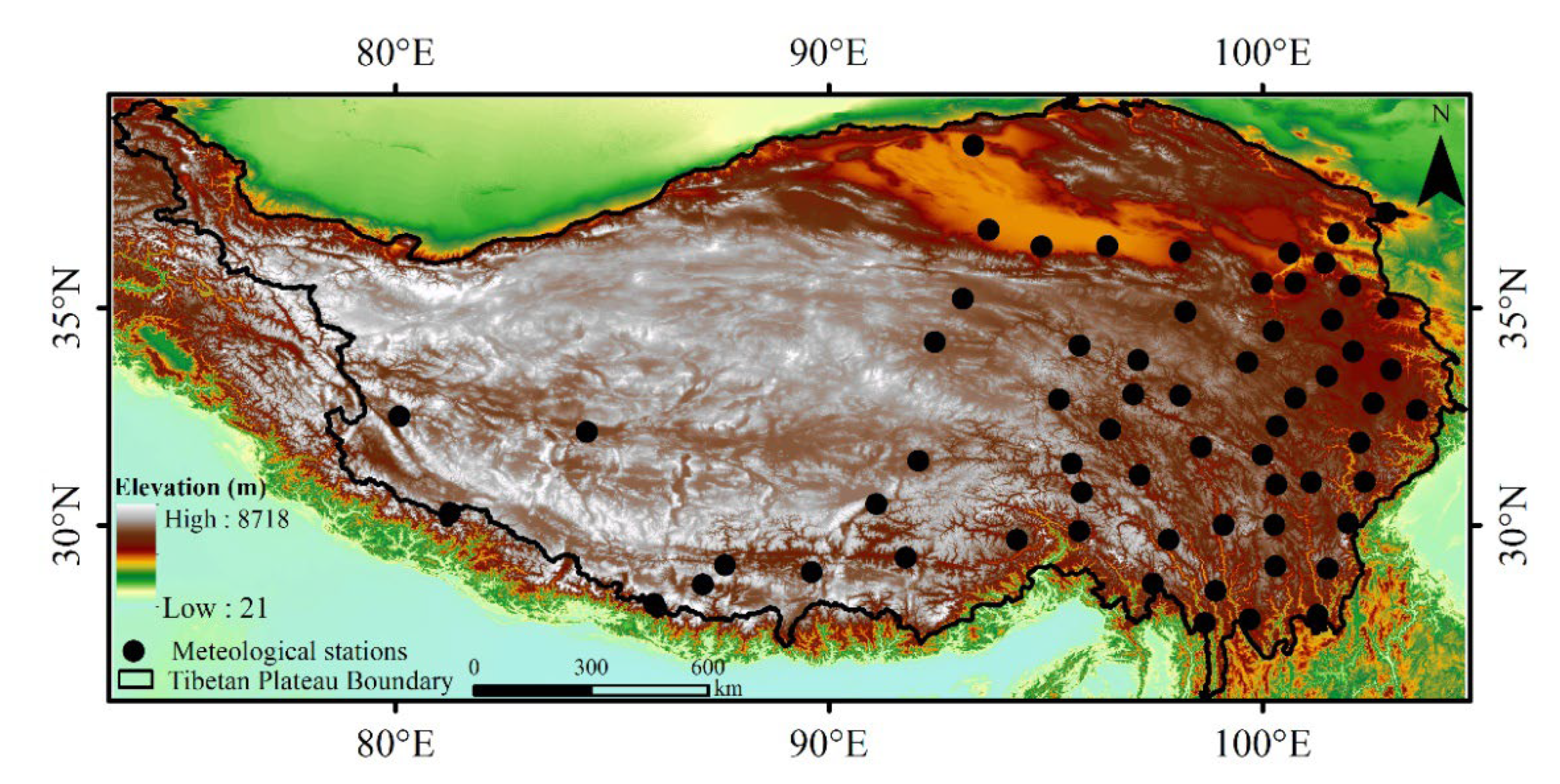



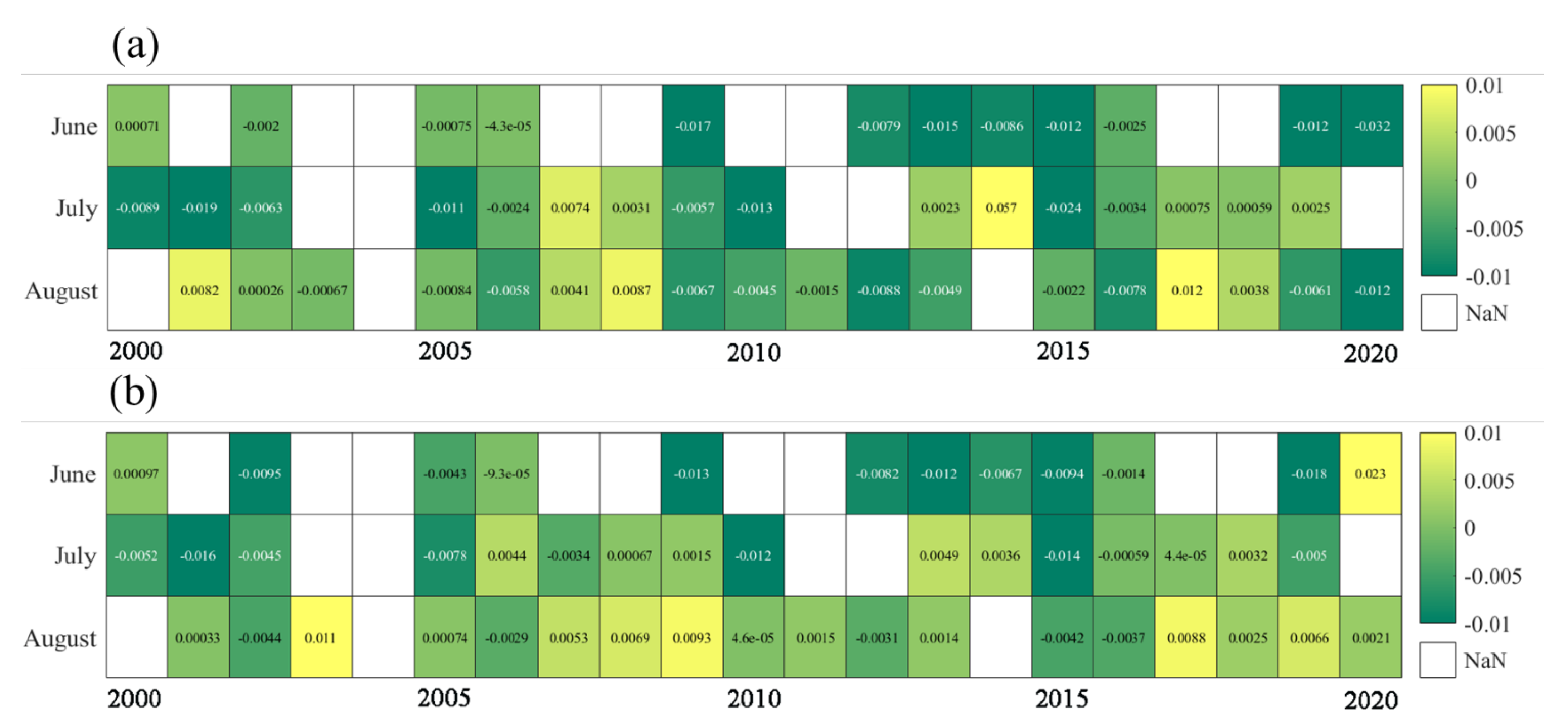


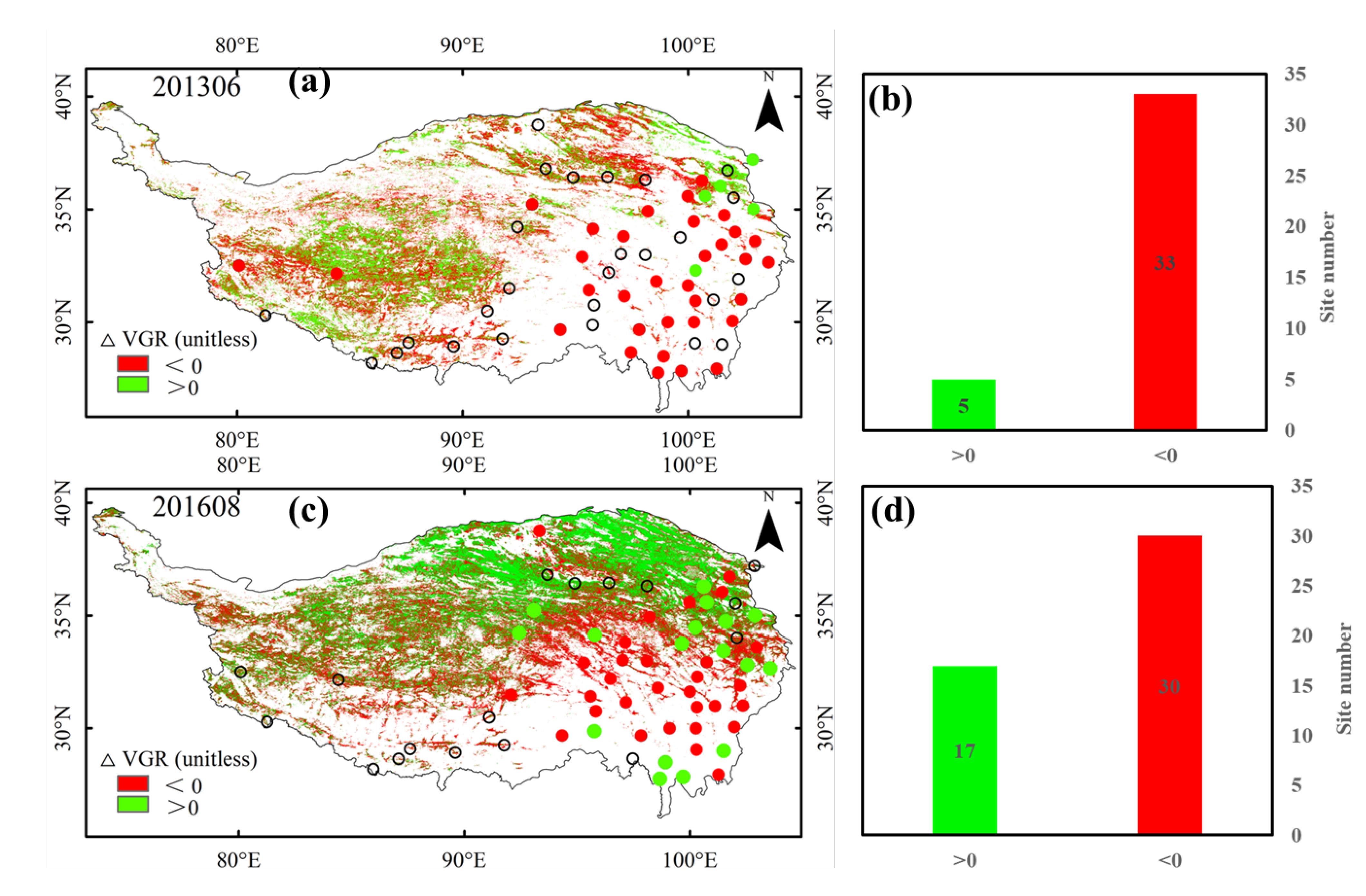
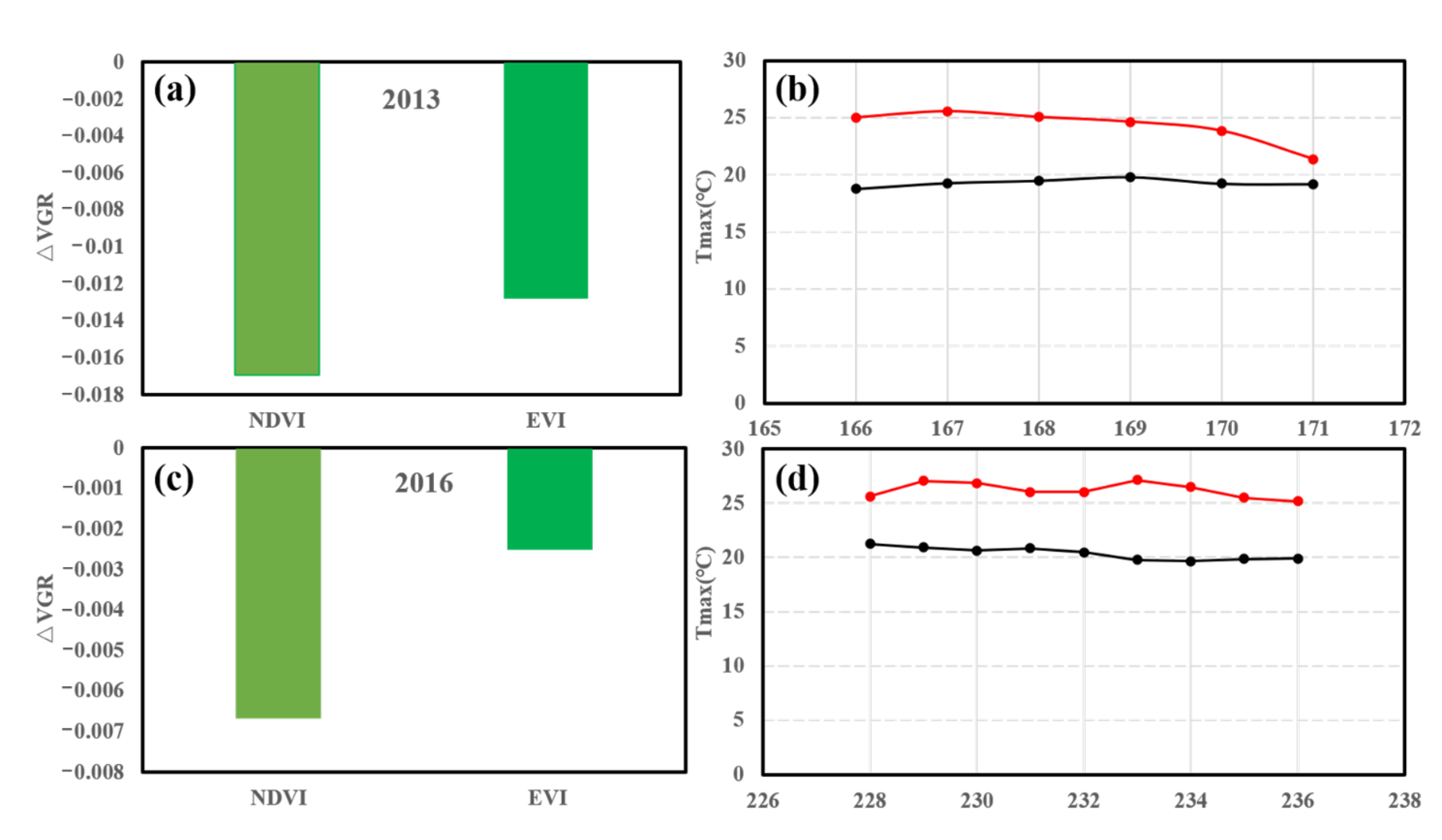

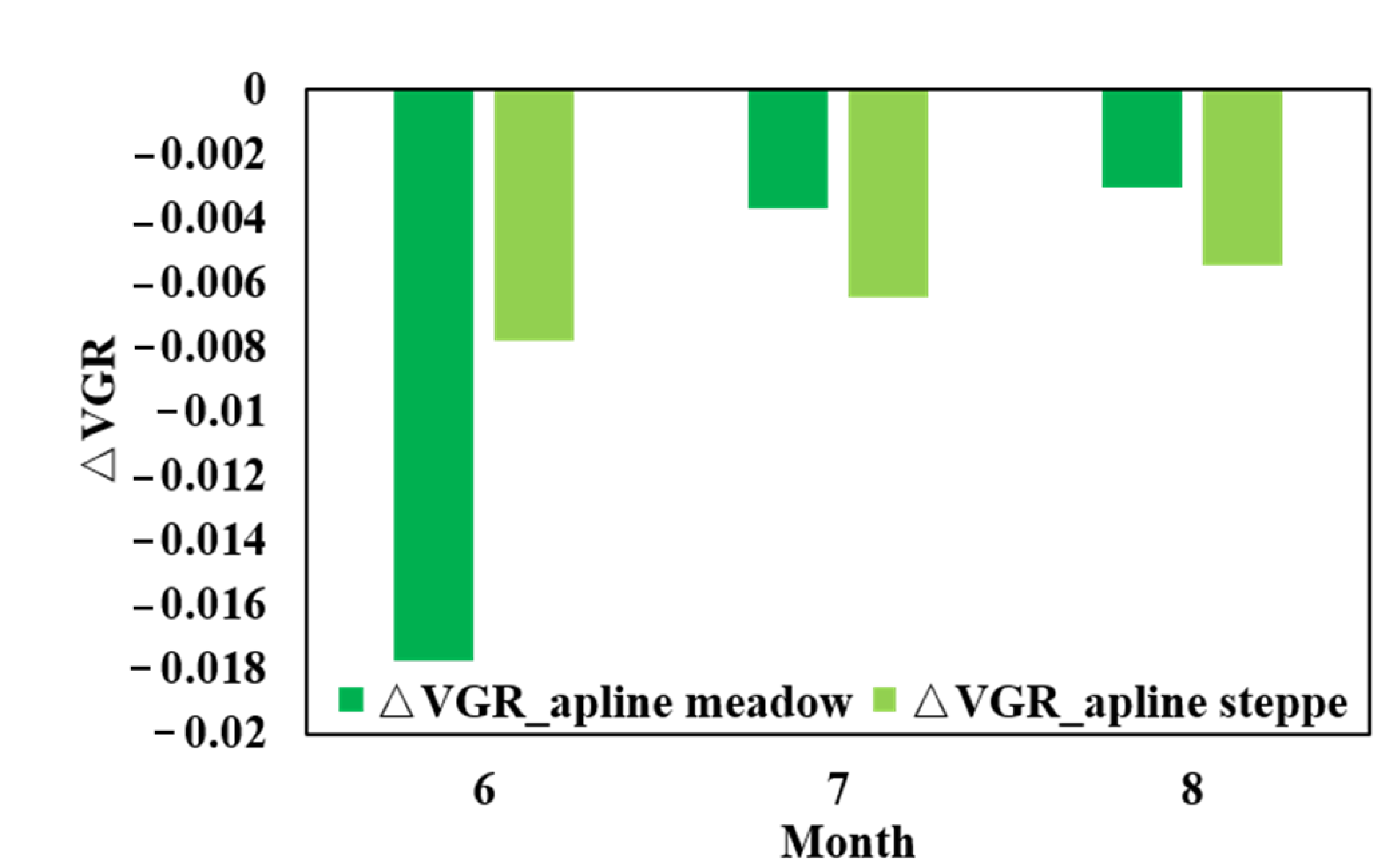
Publisher’s Note: MDPI stays neutral with regard to jurisdictional claims in published maps and institutional affiliations. |
© 2022 by the authors. Licensee MDPI, Basel, Switzerland. This article is an open access article distributed under the terms and conditions of the Creative Commons Attribution (CC BY) license (https://creativecommons.org/licenses/by/4.0/).
Share and Cite
Dong, C.; Wang, X.; Ran, Y.; Nawaz, Z. Heatwaves Significantly Slow the Vegetation Growth Rate on the Tibetan Plateau. Remote Sens. 2022, 14, 2402. https://doi.org/10.3390/rs14102402
Dong C, Wang X, Ran Y, Nawaz Z. Heatwaves Significantly Slow the Vegetation Growth Rate on the Tibetan Plateau. Remote Sensing. 2022; 14(10):2402. https://doi.org/10.3390/rs14102402
Chicago/Turabian StyleDong, Caixia, Xufeng Wang, Youhua Ran, and Zain Nawaz. 2022. "Heatwaves Significantly Slow the Vegetation Growth Rate on the Tibetan Plateau" Remote Sensing 14, no. 10: 2402. https://doi.org/10.3390/rs14102402






